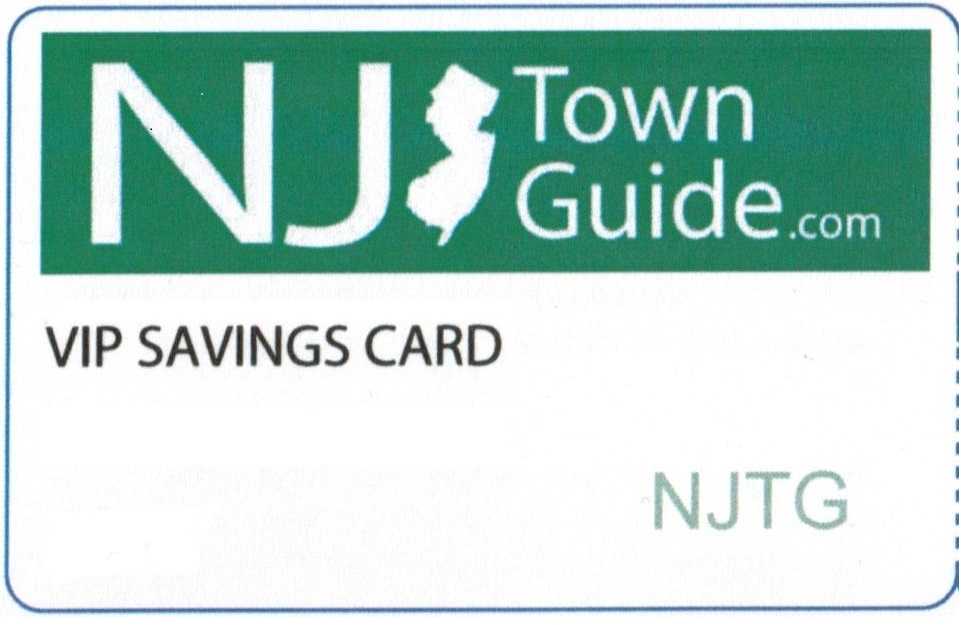Historic Places
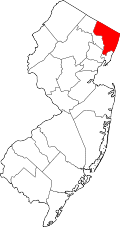
Bergen County Historical Society
1201 Main Street
River Edge, NJ 07661
201-343-9492
Many of the homes listed here are private residences and you should respect the rights and privacy of the occupents.
Van Houten-Yeomans Homestead
209 W. Allendale Avenue
Allendale, NJ 07401
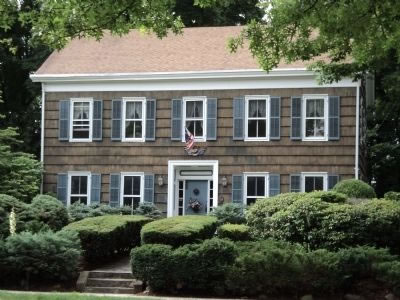
(Photo by
Bill Coughlin, courtesy of HMdb.org)
John H Van Houten came to this neighborhood in 1792 and
later purchased land. His son, Paul J. Van Houten, built this
farmhouse about 1869 on family acreage. In 1870 he willed
it to his daughter, Margeret Ann, the wife of John L. Yeomans,
a farmer, Later the Van Houten-Yeoman farm was divided
into house lots which contributed to the growth of Annendale.
The farmhouse remained in the family until 1955.
South Church
150 West Church Street
Bergenfield, NJ 07621
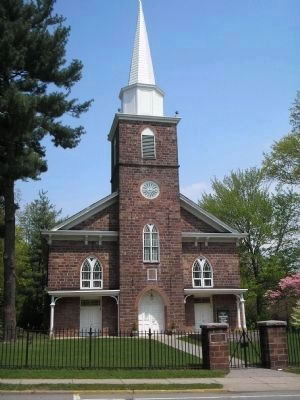
(Photo by
Bill Coughlin, courtesy of HMdb.org)
Organized in 1723 as the Schraalenburg Dutch
Reformed Church. First church was erected
in 1728 about 150 feet to the east of the present
structure in built in 1799. The True Reformed
Church was founded here in 1822. The church
became Presbyterian in 1913. John Henry
Goetschius, minister from 1748 to 1774, the
principal founder of Queens College (Rutgers),
and many Revolutionary War soldiers are
buried in the churchyard.
"Achter Col" Colony
Intersection of West Fort Lee Road and River Road
Bogota, NJ 07603
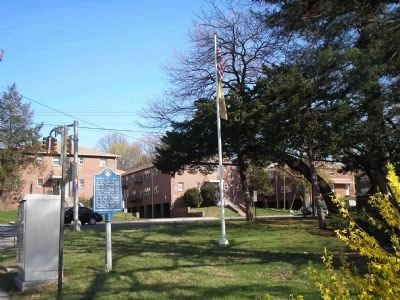
(Photo by
Bill Coughlin, courtesy of HMdb.org)
In 1642, when this area was part of New Netherland,
Johannes Winckelman built near here a ninety-foot long fur
trading post and farmhouse – a building which sheltered
both settlers and cattle. During the 1643 Indian war it was
protected by five Dutch soldiers but on the night of
September 17, 1643, it was attacked and burned to the
ground by the Hackensack and Tappan Indians. This section
of Bogota was known as “Winkelman” for many years.
Closter Public School
Durie Avenue and High Street
Closter, NJ 07624
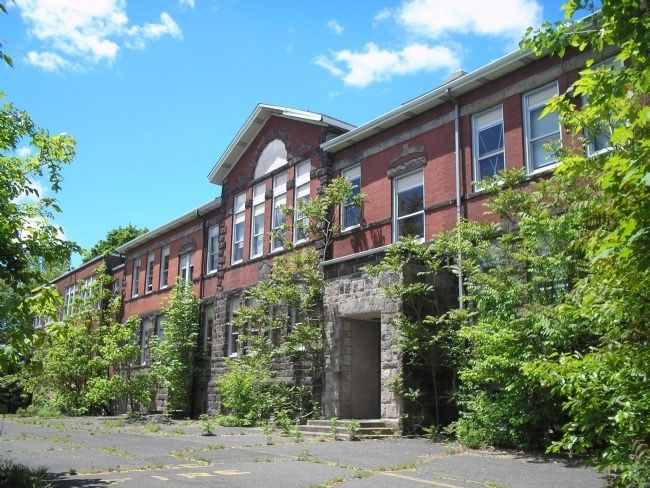
(Photo by
Bill Coughlin, courtesy of HMdb.org)
In 1899 the schoolhouse property was bought from the
Bloomer family. The following year a two story, square plan,
Renaissance Revival style building was completed with
3 classrooms and an assembly room for grades K-8. In 1907,
4 classrooms were added to the south side, and in 1912,
6 classrooms were added to the north side, expanding the
school to K-12. In 1921 the south end was again enlarged,
and from 1929 to 1955 it was solely the Closter Jr/Sr High
School, 7-12. From 1955 to 1996 it was the Village School,
grade’s 6-8.
Daniel De Clark House
145 Piermont Road
Closter, NJ 07624
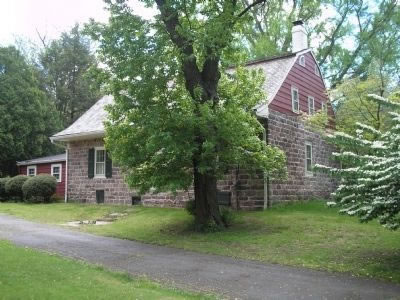
(Photo by
Bill Coughlin, courtesy of HMdb.org)
Built about 1786 by Daniel De Clark, the frame kitchen wing
was added in the early 1800’s. De Clark operated a large
cattle and dairy farm on 170 acres of land. In 1815 son
William was the owner and he sold the house to his grandson,
Jacob D.C. Outwater, in 1849. Jacob was a farmer who
also built and ran a nearby sawmill. The farmhouse passed
from the family in 1856. Later it became part of the Palisade
Stock Farm.
Hilderbrant Naugle House
West Street
Closter, NJ 07624
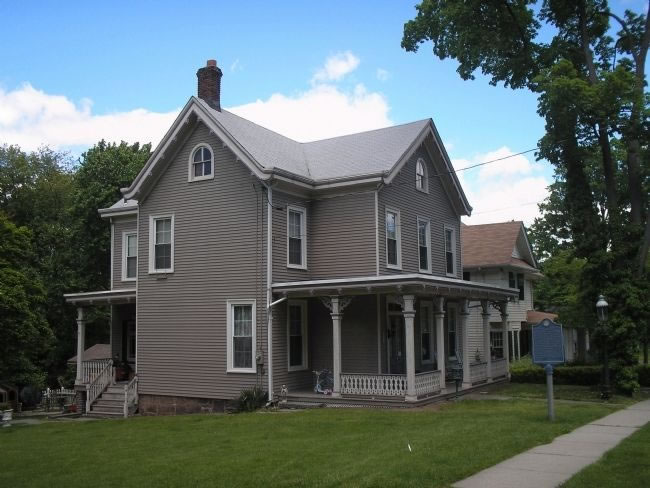
(Photo by
Bill Coughlin, courtesy of HMdb.org)
Built in 1871 for Hilderbrant Naugle on a suburban lot near
the Closter R.R. depot, the frame gable-front-and wing house
is notable for the ornamental scroll work of Gothic design.
Naugle was a carpenter and clockmaker who made
improvements to his home. He died in 1899 and the
residence was occupied by his son Resolvert Naugle,
also a carpenter. It was purchased by his son-in-law,
William Tate, in 1922 and family ownership ended in 1924.
Reformed Church of Closter
West Street and High Street
Closter, NJ 07624
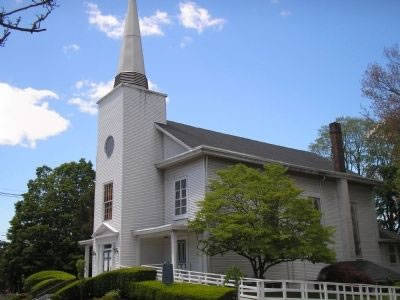
(Photo by
Bill Coughlin, courtesy of HMdb.org)
Established as the “Protestant Reformed Dutch Church of
Closter City”, it was the first church erected in the Borough
of Closter. Dedicated October 7, 1862, tradition says the
church was the headquarters of the “Harrington Rifles”,
a group of churchmen who drilled here for service in the
Civil War. In 1868, the church housed first classroom in
present Closter. The building has been enlarged and
remodeled over the years.
Walter Parcells Homestead
Piermont Road and High Street
Closter, NJ 07624
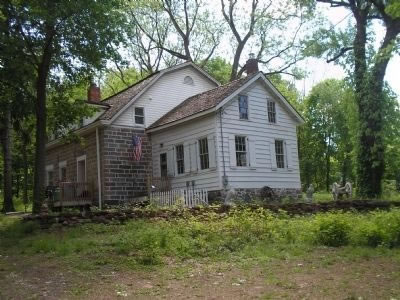
(Photo by
Bill Coughlin, courtesy of HMdb.org)
In 1795 Walter Parcells, a mason, erected this house of
local stone on 34 acres of land on what was then known as
Closter New Road. Built in the Federal style, it is 1½ stories
high with a gambrel style roof. The frame wing was added
later and another wing, on the west, no longer stands.
By 1860 it was known as the Lone Star Tavern run by
Cornelia Parcells Vanderbeck. The house remained in the
Parcells family until 1961.
Benjamin P Westervelt Homesite
County 501 and Westervelt Place
Cresskill, NJ 07626
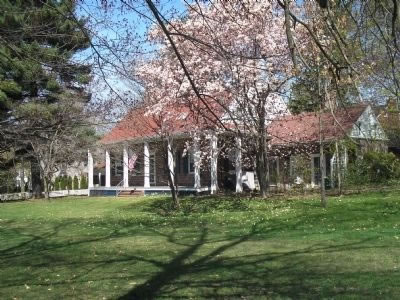
(Photo by
Bill Coughlin, courtesy of HMdb.org)
The main wing of this house was built in 1808 by Benjamin
P. Westervelt who served in the local militia during the
Revolution. The site of this house has been continuously
owned by the Westervelt family since early colonial times.
General Erskine’s maps show a Westervelt home on this
site in 1778. A fine example of the Dutch Colonial style,
it served as a background in some early moving pictures.
Cap't John Huyler's Farm
50 County Road
Cresskill, NJ 07626
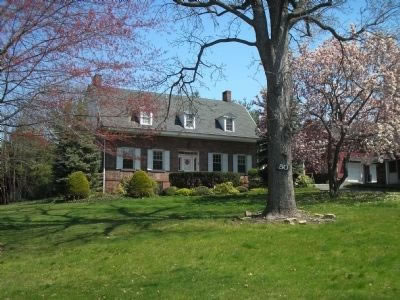
(Photo by
Bill Coughlin, courtesy of HMdb.org)
In 1776, a 180 acre farm here was owned by Loyalist John
Ackerson. It extended from the Tenakill to the Hudson,
bordered on the north by the road used by British invaders
that year. Seized as enemy property, it was bought in 1784
by Militia Captain John Huyler. The main wing of this house
was built in 1836 by his son, Peter. The stone work is
exceptional. The outbuilding of stone was probably a kitchen
with quarters for slaves.
Demarest Railroad Station
Park Street
Demarest, NJ 07627
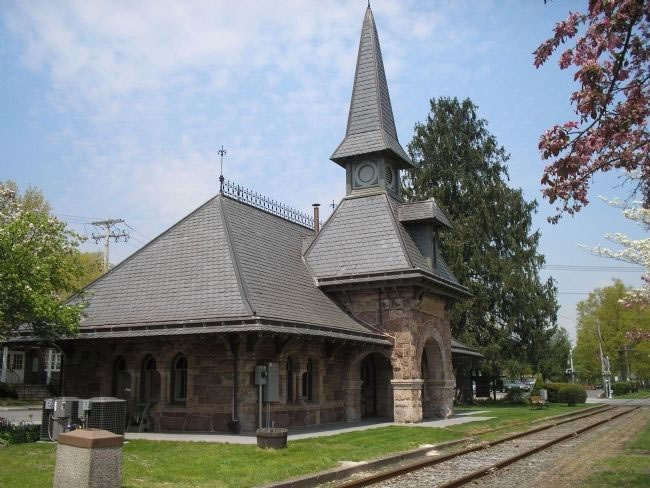
(Photo by
Bill Coughlin, courtesy of HMdb.org)
Built 1872 at “Demarests Station” on the Northern Railroad
of New Jersey. Designed by noted architect J. Cleveland Cady,
it was considered the “handsomest on the line.” The depot
was built of Palisades stone quarried on the Demarest farm.
The station was named for State Senator Ralph S. Demarest,
a director of the railroad, and his family, who owned the land.
The Borough took the name when incorporated in 1903.
Derick Banta House
180 Washington Avenue
Dumont, NJ 07628
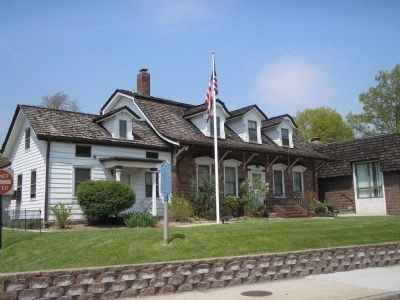
(Photo by
Bill Coughlin, courtesy of HMdb.org)
This example of Dutch Colonial architecture was built between
1780-1790 by Derick Banta, soldier in the American Revolution,
after his birthplace here was burned by Tories. Owned by the
Quackenbush family from 1792, it was sold to Isaac Dixon
in 1862, whose son Robert was Dumont’s fourth Mayor.
In 1929 Miss Sarah Dixon devised the homestead to the town
for a public library.
Old North Church
Washington Avenue and Madison Avenue
Dumont, NJ 07628
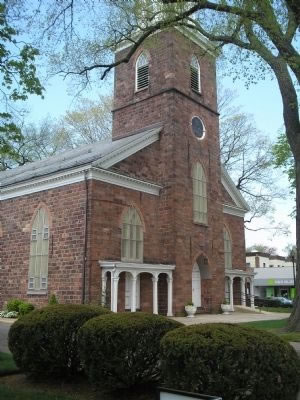
(Photo by
Bill Coughlin, courtesy of HMdb.org)
Organized in 1723 as the Schraalenburgh
Reformed Dutch Church. First church was
built in 1728. In 1801 the present Old North
Reformed Church was built, one mile north of
first site, and continues as a Reformed
congregation. This sanctuary is considered
one of the finest examples of early American
church architecture. Its churchyard is the resting
place of many Revolutionary War soldiers.
Ferryboat Binghamton
Binghamton Way
Edgewater, NJ 07020
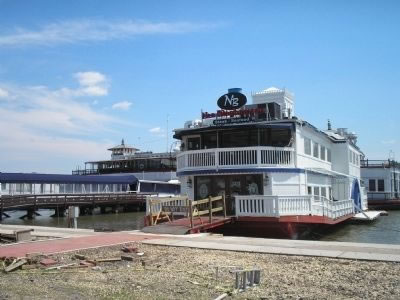
(Photo by
Bill Coughlin, courtesy of HMdb.org)
Built for the Hoboken Ferry Company and launched in1905,
it plied the Hudson River between Hoboken and Manhattan
(Barclay St.) for 62 years. This double-ender steamboat was
designed to carry 986 passengers and a number of vehicles.
It was in operation until 1967 when all ferry service on the river
ceased. Moored here in 1975, the Binghampton was converted
to a restaurant. The vessel was placed on the National Register
of Historic Places in 1982.
Van Houten-Hillman House
891 River Drive
Elmwood Park, NJ 07407
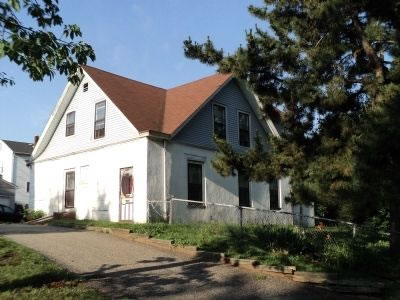
(Photo by
Bill Coughlin, courtesy of HMdb.org)
Built c. 1782 by Cornelius J. Van Houten as an addition to
the earlier house of his father, John C. Van Houten. Located
in “Slotterdam”, the farm stretched between the Passaic and
Saddle Rivers and was raided during the Revolutionary War
by the British in 1776. Later owned by the Cadmus and
Brooks families, it was purchased in 1888 by Herman Hillman.
In 1901 he remodeled the homestead which he and his
descendants have owned for five generations.
Brookside Chapel
Engle Street
Englewood, NJ 07631
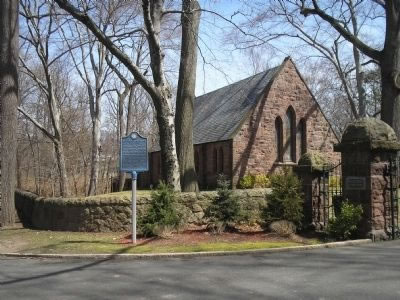
(Photo by
Bill Coughlin, courtesy of HMdb.org)
Built in 1860 on Palisade Avenue as “The Englewood
Presbyterian Church”, it was the first church established in
the city. A new, larger church was built on the original site and
the old building was taken down, stone by stone, and
re-erected at Brookside Cemetery about 1877. The sandstone
church, later known as the “Chapel”, is in the Gothic Revival
architecture. Brookside Cemetery was established in 1876.
De Mott - Westervelt House
285 Grand Avenue
Englewood, NJ 07631
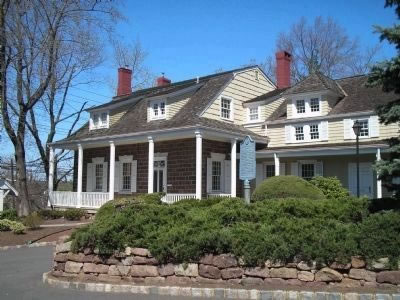
(Photo by
Bill Coughlin, courtesy of HMdb.org)
Built about 1808 by Henry DeMott, this sandstone Dutch
Colonial house was once attached to the pre-Revolutionary
homestead of Albert Lydecker. Material from the older house
used in the present frame wing built c. 1810 by Peter Westervelt.
The Westervelt family owned the homestead until 1936.
Adjacent Dutch Barn is an adaptation of the European
“bouwhuys”, or farmhouse, where men and cattle lived under
one roof.
English Neighborhood Union School
484 Tenafly Road
Englewood, NJ 07631
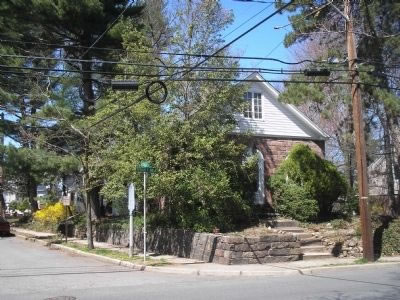
(Photo by
Bill Coughlin, courtesy of HMdb.org)
This former school was originally built in 1818 near the Liberty
Pole Tavern. In 1850 it was moved here and rebuilt with the
original materials. This part of Englewood was then known as
Highwood. The name Englewood School was adopted in 1897.
It continued to be used as a school until the close of the century.
First Presbyterian Church
150 East Palisades Avenue
Englewood, NJ 07631
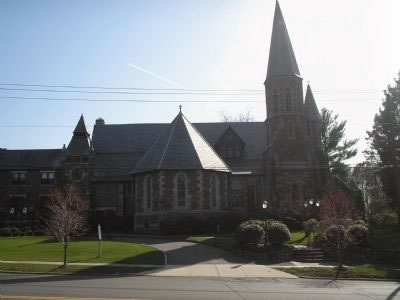
(Photo by
Bill Coughlin, courtesy of HMdb.org)
Organized in 1860 as “The Englewood Presbyterian Church”,
the first edifice was erected on this site in the same year.
It was the first church building in Englewood and the first
Presbyterian congregation in Bergen County. Today’s structure
was built in 1870 in Victorian Gothic style of architecture.
Over the years the church has been enlarged and remodeled.
John G. Benson House
Grand Avenue and Tracey Place
Englewood, NJ 07631
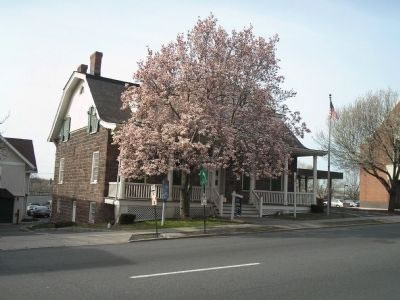
(Photo by
Bill Coughlin, courtesy of HMdb.org)
Built c. 1800 by John G. Benson, a farmer, and from 1794 to
1797, a captain in the militia. This house, an example of
post-Revolutionary War Dutch Colonial architecture, was
built on property confiscated by New Jersey from the
Reverend Garret Lydecker, a Tory during the American
Revolution.
Saint Paul's Episcopal Church
113 Engle Street
Englewood, NJ 07631
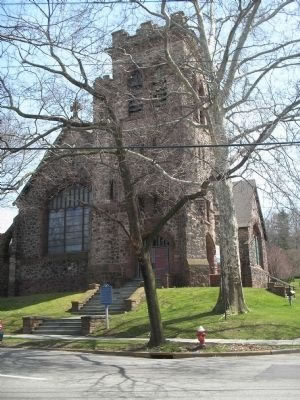
(Photo by
Bill Coughlin, courtesy of HMdb.org)
Organized in 1865, the congregation first met
in homes and in the armory on Van Brunt St.
The original church was built in 1866. The present
chapel was erected in 1895 as a parish hall.
Today’s Gothic church structure, built in 1899,
has the rose limestone of the original building
in its foundation. The stained glass are from
Tiffany, La Farge, and Lamb Studios.
Jacob Vanderbrock House
Saddle River Ave & Dunker Hook Road
Fair Lawn, NJ 07410
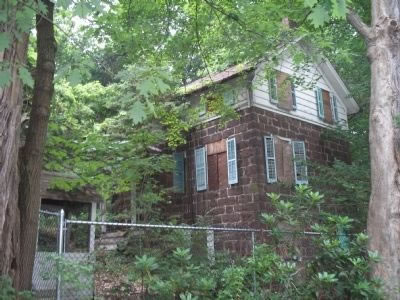
(Photo by
Bill Coughlin, courtesy of HMdb.org)
Although labeled as Naugle House this colonial home was
built in the 18th century by Jacob Vanderbeck in the 1740/50's.
The Vanderbeck Family owned much of the land in the area
at the time. Naugle may have lived there one time and he
was said to have been a paymaster in Layayette’s
Light Division. The house served as a landmark on many
Revolutionary War maps. It is believed that Lafayette visited
here in 1824.
Ackerman-Boyd House
1095 Franklin Lake Road
Franklin Lakes, NJ 07417
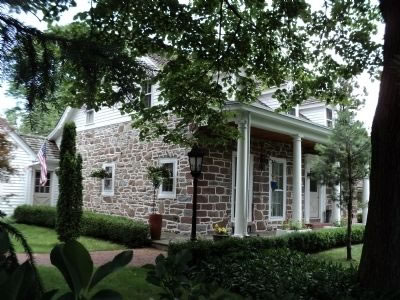
(Photo by
Bill Coughlin, courtesy of HMdb.org)
Built about 1793 by James A. Ackerman on land owned by
the family since 1727. The farm was then in the locality known
as Ponds Neighborhood and within the old Township of
Franklin. In 1841 the house was purchased by Adam Boyd
who farmed the land and was also a noted lobbyist at Trenton.
The farmhouse was owned by Boyd heirs until 1901 and has
been remodeled over the years.
Franklin Lakes United Methodist Church
Pulis Avenue and Mabel Ann Avenue
Franklin Lakes, NJ 07417
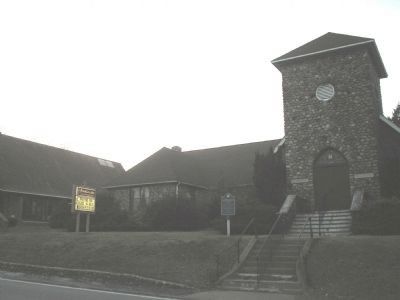
(Photo by
Bill Coughlin, courtesy of HMdb.org)
Organized in 1855 as the Methodist Episcopal Church of
Campgaw, the first church was built on Circle Ave, in 1856,
but was destroyed by fire in 1919.
William V. Pulis donated a lot ‘in a most commanding part
of the village.’ and the stone church was completed in 1921,
built of rocks from the farmers’ fields.
For many years the only church to serve the community,
the new sanctuary was added in 1968 to serve the growing
congregation.
Hopper Homestead
724 Ackerman Avenue
Glen Rock, NJ 07452
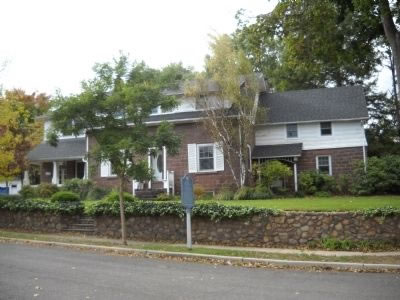
(Photo by
Bill Coughlin, courtesy of HMdb.org)
North wing built 1780
by Hendrick H. Hopper
in area then
called
“Small Lots”. Center section erected by
son John,
in early 1800’s.
The farmhouse was sold to the Hillmann
family
in 1895, ending
four generations and
115 years of
continuous
Hopper ownership.
Hopper House
470 Prospect Street
Glen Rock, NJ 07452
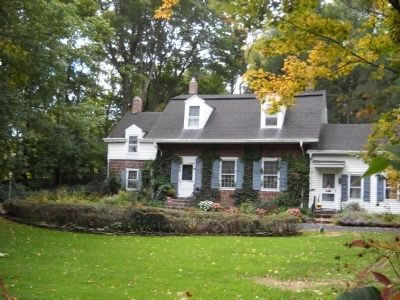
(Photo by
Bill Coughlin, courtesy of HMdb.org)
Located in “Small Lots”,
Henry G. Hopper began the
construction of this house about 1788 on a 120 acre
farm.
Son Garret erected
the Dutch-style main house in the early
1800’s. The
north frame wing was built
in the 1850’s for
his son Thomas who inherited the
homestead in 1872.
His son,
Garret T., was a Glen Rock
founder and councilman.
He sold the house in 1897
after more than a century
of
family ownership.
The Red Brick Schoolhouse
Rock Road and Ackerman Avenue
Glen Rock, NJ 07452
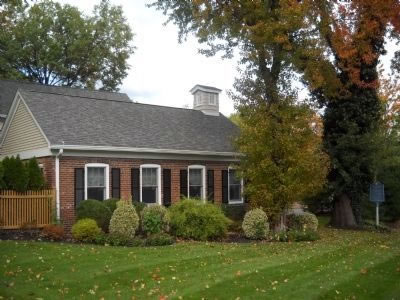
(Photo by
Bill Coughlin, courtesy of HMdb.org)
This former one room
Schoolhouse was the
original
Ridgewood Grove
School Number 44. Built
in 1846 it was
used
until 1894 by Ridgewood
Township. In 1894 the
proposed closing of this
school resulted in the
incorporation
of the Borough of Glen Rock.
It served this area as a
school
until March 8, 1900.
Historic First Reformed Church
Court Street and Church Street
Hackensack, NJ 07601
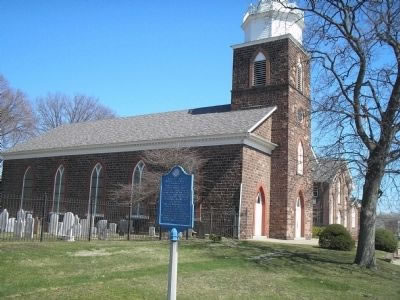
(Photo by
Bill Coughlin, courtesy of HMdb.org)
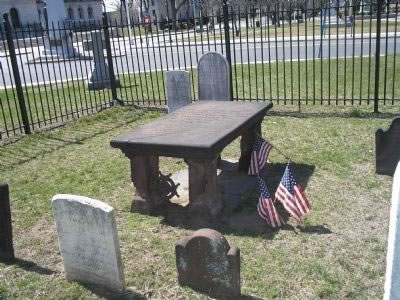
(Photo by
Bill Coughlin, courtesy of HMdb.org)
Earliest records of this pioneer Dutch church, dated 1686,
mark it as the second oldest in New Jersey. Old stones
embedded in the east wall show the initials of founding
families and first settlers. The old burying ground contains
the grave of General Enoch Poor, a Revolutionary officer.
His funeral was attended by Generals Washington and
Lafayette and a portion of the American army.
Varick Memorial African Methodist Episcopal Zion Church
120 Atlantic Street
Hackensack, NJ 07601
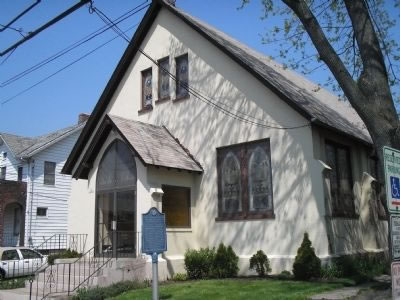
(Photo by
Bill Coughlin, courtesy of HMdb.org)
First African American Church in Hackensack. Organized in
1864 as “Olive Branch Colored Mission Number Three of
Hackensack.” First church was an old lime shed moved
here in 1867. In 1917 current name was adopted in honor
of the first Bishop of the A.M.E. Zion Church, Bishop James
Varick. The present sanctuary built in 1919.
Abraham D. Blauvelt Homestead
622 Lafayette Road
Harrington Park, NJ 07640
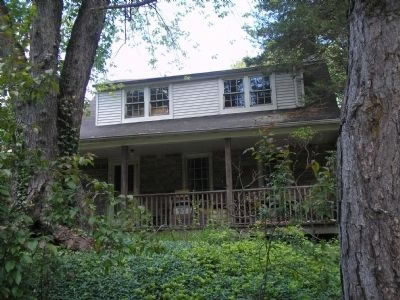
(Photo by
Bill Coughlin, courtesy of HMdb.org)
The house and the kitchen wing were built about 1801 by
Abraham D. Blauvelt who farmed the land. It came into
possession of his niece, Catherine Blauvelt, wife of
Richard J. Blauvelt, and remained in the family until 1891.
In 1904 Herman Steinhoff, a later owner, established the
Rosewood Nursery which was continued by Freidrich and
Karl Weiss when they purchased the premises in 1943.
The Federal Period house was remodeled over the years.
Blanch-Haring House
341 Lafayete Road
Harrington Park, NJ 07640
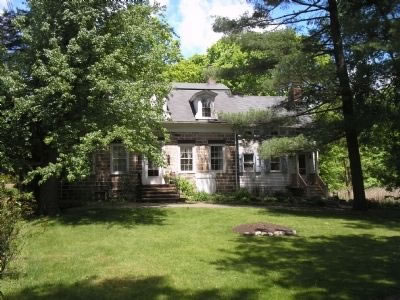
(Photo by
Bill Coughlin, courtesy of HMdb.org)
Homestead of Isaac Blanch from about 1758 and site of his
grist mill, both inherited in 1767 from his father, Richard Blanch,
a native of England. Isaac was a Patriot official and member
of the State Assembly during the Revolutionary War. He was
taken prisoner by Tory raiders early in 1777 and jailed in
New York until exchanged late that year. Property sold
about 1788 to David Haring whose family owned it for the
following century.
Old Burying Ground
Tappan Road and Arcadia Court
Harrington Park, NJ 07640
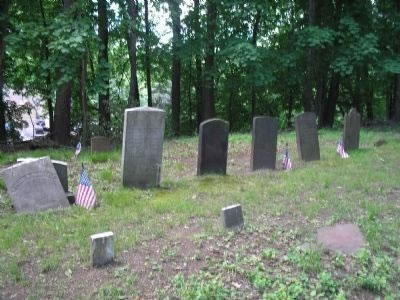
(Photo by
Bill Coughlin, courtesy of HMdb.org)
In use for nearly two hundred years, largely by the Blauvelt
family, the earliest known burial was in 1722. The cemetery
contains the graves of members of other early Bergen
County families, veterans of the American Revolution and
slaves. Some of the tombstones are inscribed in Dutch.
Wortendyke Homesite
11 Harriot Avenue
Harrington Park, NJ 07640
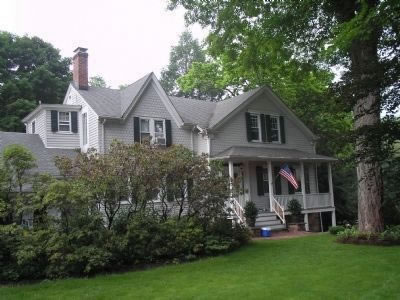
(Photo by
Bill Coughlin, courtesy of HMdb.org)
Frederick Wortendyke owned this land in 1723. It was once
part of a large grant called the Tappan Patent. His son Jacob,
who owned the homestead during the Revolutionary War, was
taken captive in one of many British raids made in the area.
Later owners included members of the Blauvelt, Demarest
and Herring families. The house, rebuilt over the years, is now
a combination of eighteenth and nineteenth century architecture.
Garret J. Durie House
371 Schraalenburg Road
Haworth, NJ 07641
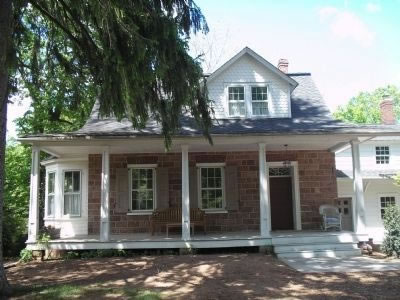
(Photo by
Bill Coughlin, courtesy of HMdb.org)
An early 19th century example of Dutch Colonial architecture
erected by Garret J. Durie on part of the estate of his father,
John Durie. Garret J. Durie was a farmer whose 120 acre
tract stretched eastward one mile to the Tenakill Brook.
Located in what was once known as Schraalenburg, the
house was occupied by Durie heirs – the Westervelt and
Mount families – until 1946.
Zabriskie-Christie House
317 Massuchesetts Avenue
Haworth, NJ 07641
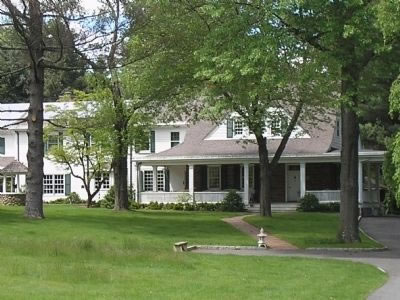
(Photo by
Bill Coughlin, courtesy of HMdb.org)
Built 1818 by Garret H. Zabriskie on land his father Henry
purchased in the 18th century. Garret's farm consisted of 219
acres. It began on Schraalenburg Road and ran westward for
one mile. Later owned by son John G. Zabriskie who sold it to
his grandson John H. Christie in 1894. Christie, one of
Haworth’s first councilmen, enlarged and remodeled the
house. It was sold in 1936 after 118 years of Zabriskie-Christie
ownership.
Garret Durie House
156 Ell Road
Hillsdale, NJ 07642
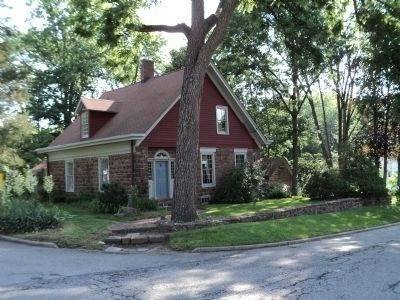
(Photo by
Bill Coughlin, courtesy of HMdb.org)
Located in “Pascack” on land inherited from his father,
Garret Durie built this house about 1767. During the Revolutionary
War, the house was plundered by both American and British armies.
Durie was a farmer and a blacksmith as well as a Bergen County
Freeholder, Justice and Judge. The house, later enlarged, was
inherited by his daughter and through her passed to the Terhune
and Hopper families.
Westervelt-Demarest House
Hillsdale Avenue
Hillsdale, NJ 07642
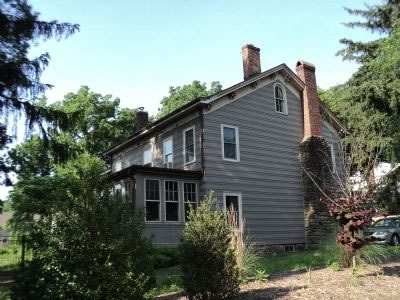
(Photo by
Bill Coughlin, courtesy of HMdb.org)
About 1756 Peter Westervelt built a small house, enlarged
in 1785, on land of his wife Catlyntje Haring. During the
Revolutionary War the farm was raided. Later it was owned
by son Henry and his son Aaron, a Freeholder and State
Assemblyman. Purchased in 1860, he built the addition in
Italianate style of the north side of the old house. Alterations
were made over the years. A later owner was
William W. Livengood, Mayor of Hillsdale in 1930.
Vreeland House
125 Lakeview Drive
Leonia, NJ 07605
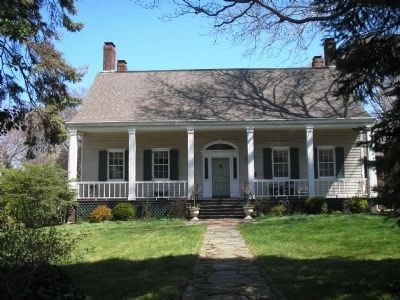
(Photo by
Bill Coughlin, courtesy of HMdb.org)
Located in old English Neighborhood on land purchased by
Dirck Vreeland before the Revolution, the homestead stretched
between the Hudson River and Overpeck Creek. The stone
wing of this house was built about 1786 and later was
remodeled. Son Michael D. Vreeland added the main Dutch style
house about 1815 which is noted for its Federal decorative
detail. It remained in the Vreeland family until 1928.
River Road School
400 Riverside Drive
Lyndhurst, NJ 07071
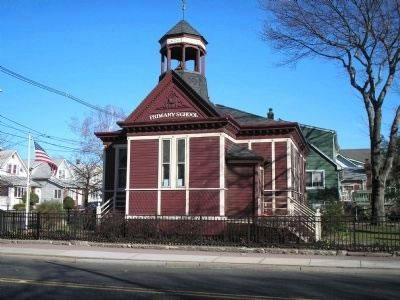
(Photo by
Bill Coughlin, courtesy of HMdb.org)
The first schoolhouse was built on this site in 1804. Located
in what then was called New Barbadoes Neck, the land was
donated by Jacob Van Winkle “for the sole purpose of erecting
a School House”. In 1849 it was replaced by a two-story building.
The present one-room school, with Queen Anne style cupola,
was built in 1893. It continued to be used as a Lyndhurst
school until 1978.
Laroe-Van Horn House
398 Ramapo Valley Road
Mahwah, NJ 07430
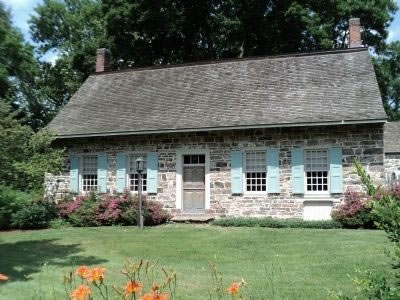
(Photo by
Bill Coughlin, courtesy of HMdb.org)
Located in “Ramapough” near the site of an Indian trading post,
this Dutch Colonial house was built about 1750 by Jacobus
Laroe. The small wing was added at a later date, the porch
about 1840. Some later owners were Jacobus Bogert who
had a tavern here; John Haring, a member of the Continental
Congress; the Hopper family and Abraham Van Horn,
a Bergen County Freeholder and New Jersey Assemblyman.
Mahwah's First Station
Old Station Lane and Ramapo Avenue
Mahwah, NJ 07430
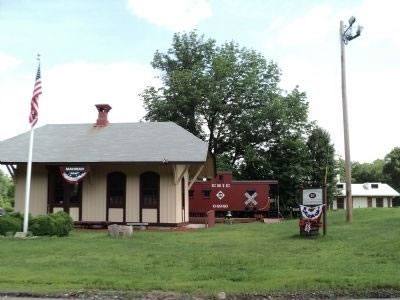
(Photo by
Bill Coughlin, courtesy of HMdb.org)
Built in 1871, the building served until 1902 and was moved
from original site when four tracks were laid and grade crossing
closed. Bought by A.J. Winter, it was used as a storehouse for
fifty years. To preserve the landmark, The Mahwah Historical
Society was founded in 1965 and the station removed to present
site in 1967. Completely restored, it was dedicated as a town
museum on Sept. 22, 1968 by Gov. Richard Hughes.
Eckerson House
280 Chestnut Ridge Road
Montvale, NJ 07645
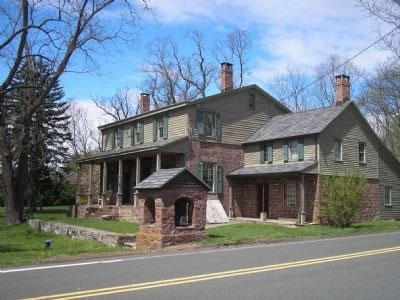
(Photo by
Bill Coughlin, courtesy of HMdb.org)
Built in the 1790’s by Jacob Eckerson near an earlier home
where he had settled about 1770. The farmstead then consisted
of 119 acres. The house was inherited by his son John J.
Eckerson in 1810 who owned it until 1870 when purchased
by James Ledwith. The frame second story was added in the
1890’s. John Foxlee bought the house and farm in 1917
and it was occupied by that family until 1971.
Demarest-Bloomer House
147 River Edge Avenue
New Milford, NJ 07646
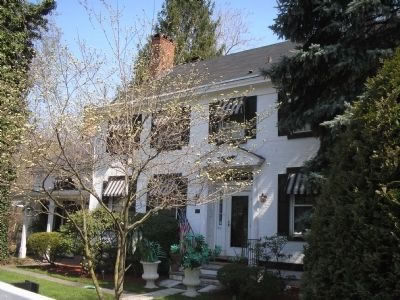
(Photo by
Bill Coughlin, courtesy of HMdb.org)
Built about 1840 in the Greek Revival Style of architecture by
John C. Demarest. He was a farmer with an interest in river trade
when schooners plied the Hackensack River. The house was
purchased in 1864 by George Bloomer, a dealer in coal and lumber,
and his family owned it until 1928. This locality was known at
different times as Demarest’s Landing, Bloomer’s Landing,
and Old Bridge.
Jacobus Demarest Homestead
618 River Road
New Milford, NJ 07646
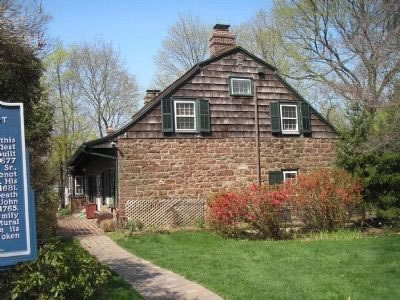
(Photo by
Bill Coughlin, courtesy of HMdb.org)
The earliest part of this house, one of the oldest in the county,
was built on land purchased in 1677 by David Demarest, Sr.,
founder of the Huguenot Colony in Bergen County. His grandson
Jacobus, born 1681, lived here until his death in 1763. Jacobus’
son John completed the house in 1765. It remained in the family
until 1850. An architectural feature surviving from its early days
is its unbroken gambrel roof.
Hendrick Van Allen House
Franklin Avenue and Ramapo Valley Road
Oakland, NJ 07436
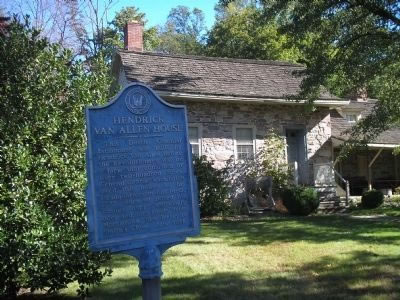
(Photo by
Bill Coughlin, courtesy of HMdb.org)
This Dutch Colonial house was built by Hendrick Van Allen
before the Revolutionary War on a farm that consisted of
over two-hundred acres. General George Washington used
this house as his Headquarters on July 14-15, 1777, when
he moved his troops over “extremely deep and miry roads”
from Morristown, New Jersey to Smith’s Clove, New York.
Jacobus S. Demarest House
3 Dogwood Avenue
Oakland, NJ 07436
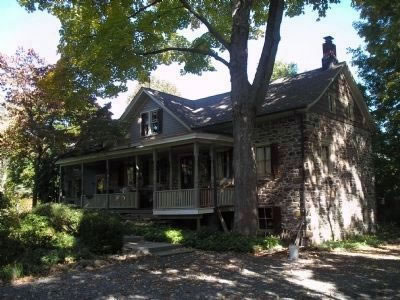
(Photo by
Bill Coughlin, courtesy of HMdb.org)
Built about 1789 by Jacobus S. Demarest, the frame wing
was added later. Demarest served in the Revolutionary War.
Over the years his farm grew to 180 acres. In 1835 his son,
Daniel J. Demarest, inherited the farmhouse. In 1863 it passed
to his daughter, Letty Ann, and in 1894 to her son Daniel J. Fox.
Daughter Irene Fox Munzinger was the last of the Demarest
line to occupy the house after 194 years in the family.
Claudius O. Collignon House
1019 Westwood Avenue
Westwood, NJ 07675
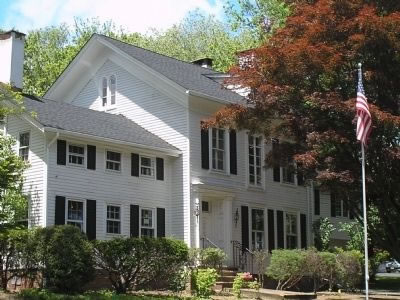
(Photo by
Bill Coughlin, courtesy of HMdb.org)
Built about 1864 by Claudius with a kitchen wing, it has elements
of Greek Revival and Italianate styles of architecture. He purchased
a half interest in the farm and mill works owned by his brother
Nicholas. Their firm was known as the Collignon Brothers, noted
for chair manufacture, including the patented folding deck chairs
for ocean liners. The house, with later additions and remodeling,
remained in the family until 1895. The mill burned down in 1904.
John Haring, Jr House
392 Old Tappan Road
Westwood, NJ 07675
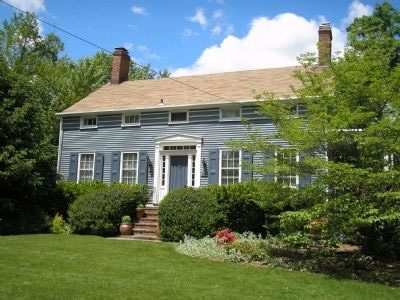
(Photo by
Bill Coughlin, courtesy of HMdb.org)
Built about 1836 by John Haring, Jr., the house is an example
of Greek Revival architecture and retains many original features.
Haring’s homestead was on 14½ acres but he also owned
adjacent lands which he farmed for decades. Daughter Sarah
Elizabeth, wife of Jacob G. Demarest, a merchant, inherited
the premises. In 1908 it came into possession of Nellie and
Walter Fred and in 1959 it was purchased by the Williams family.
Teunis Haring House
70 Old Tappan Road
Westwood, NJ 07675
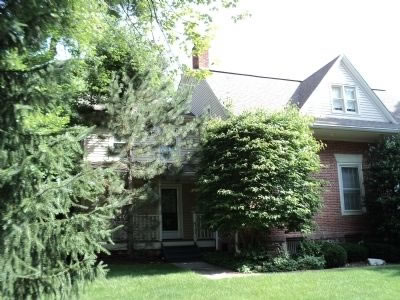
(Photo by
Bill Coughlin, courtesy of HMdb.org)
Erected about 1810 on the site of an earlier house, the brick
and sandstone center section is Dutch Colonial style, with wings
added c. 1820-1875. It was the homestead of Teunis Haring,
a farmer and Chosen Freeholder of Bergen County. Later
owned by son John T. Haring, also a Freeholder, it was occupied
by the family for 100 years. Silent motion pictures were
produced here about the time of World War I; later it was the
“300 House” tavern.
Richard T Cooper House
234 Kindermack Road
Oradell, NJ 07649
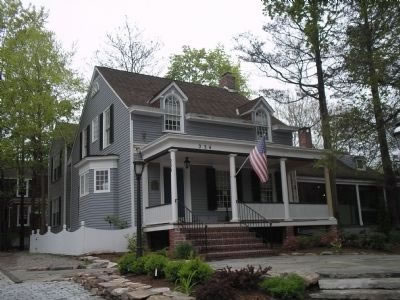
(Photo by
Bill Coughlin, courtesy of HMdb.org)
Built about 1825 by Richard Teunis Cooper, a chairmaker,
on land owned by the family since 1716. This Federal style
house, once on a 22 acre farm, is in the Oradell locality formerly
known as New Milford. Son John R. Cooper, a master blacksmith,
sold the homestead in 1866 and entered the ministry. Later owners
have made additions and remodeled the interior of the house.
Van Buskirk-Oakley House
467 Kinderkamack Road
Oradell, NJ 07649
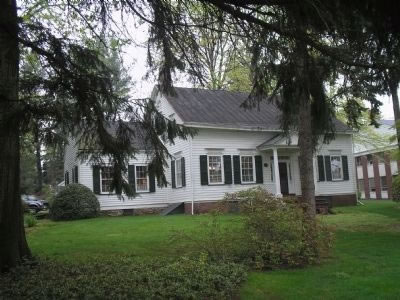
(Photo by
Bill Coughlin, courtesy of HMdb.org)
Small wing built by Abraham J. Van Buskirk about 1820 from
earlier c. 1789 house. Federal style main wing built c. 1832-34
for Fanning T. Oakley and wife Hetty Van Buskirk. Later owned
by son Abraham V. B. Oakley and wife Eliza Voorhis; their
daughter Margaret Hoyt acquired the house in 1900.
It remained in the family until 1978. The 211 acre farm in
“Kinderkamack” once stretched from the Hackensack River
to Paramus.
Jacob J. Zabriskie House
617 Paramus Road
Paramus, NJ 07652
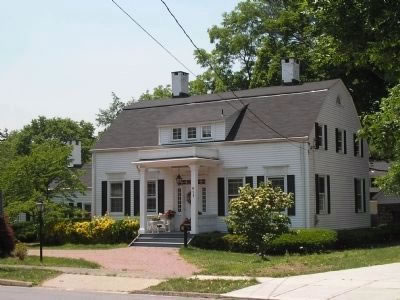
(Photo by
Bill Coughlin, courtesy of HMdb.org)
Built c. 1826, this house combines the Federal style of
architecture with that of the earlier Dutch Colonial. Erected by
Jacob J. Zabriskie on the site of an earlier home, the farmhouse
remained in the Zabriskie family for 132 years.
Old Spring Valley Burial Ground
224 Spring Valley Road
Paramus, NJ 07652
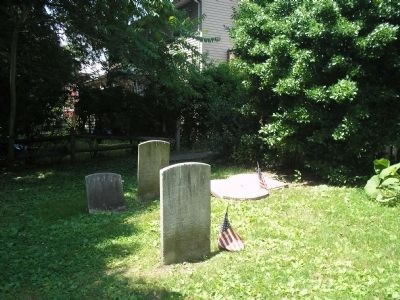
(Photo by
Bill Coughlin, courtesy of HMdb.org)
The historic cemetery directly in the rear of the Behnke farm
contains the graves of descendants of early settlers in this area
including a least two local farmer-militiamen of the American
Revolution, Jacobus Brouwer and Henry Banta, as well as
the grave of Cornelius Demarest, who served in the 22nd
regiment of the Union Army during the Civil War.
One-Room Schoolhouse
239 W.Midland Avenue
Paramus, NJ 07652
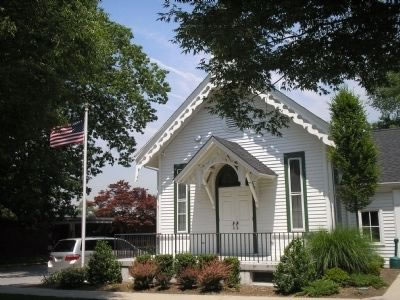
(Photo by
Bill Coughlin, courtesy of HMdb.org)
This sturdy old frame building is a landmark in the community,
having served Paramus residents in various ways. Originally
School No. 26 of Midland Township, it was converted into a
borough hall when Paramus Borough was formed in 1922.
In 1959 it became the main quarters of the Paramus Free
Public Library 83 years after it had been erected.
Rutan-Terhune-Bidwell House
Paramus Road
Paramus, NJ 07652
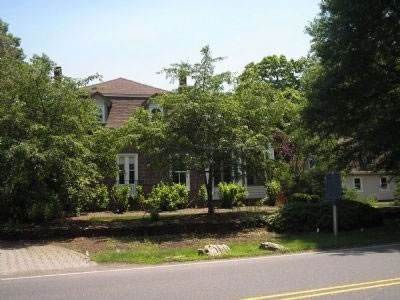
(Photo by
Bill Coughlin, courtesy of HMdb.org)
Built by Jacobus Rutan, a farmer, on 32 acres of land
about 1794-95. In 1800 his widow and son sold the house to
Cornelius H. Zabriskie, a blacksmith and farmer. In 1856
he deeded the house to his grandson, Cornelius Zabriskie
Terhune, also a farmer. The property was sold in 1869 to
Rebecca S. Bidwell, wife of John A. Bidwell who farmed
the land. They remodeled the house, including a new roof in
the French mansard style, popular at the time.
Stephen T. Zabriskie House
375 Paramus Road
Paramus, NJ 07652
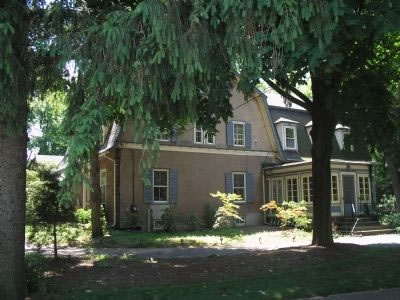
(Photo by
Bill Coughlin, courtesy of HMdb.org)
Built on the farm of his grandfather, Christian J. Zabriskie,
who bought the property in 1775. Tradition places a house
on the site in 1792 but the present stone dwelling was
probably built in the early 1800’s and occupied by
Stephen T. Zabriskie. It was later owned by his son,
Thomas V. B. Zabriskie, who added the frame wing in the
19th century. The house has been greatly altered over
the years.
Terhune-Gardner House
218 Paramus Road
Paramus, NJ 07652
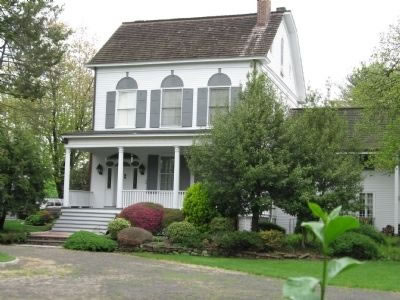
(Photo by
Bill Coughlin, courtesy of HMdb.org)
Pre-Revolutionary homestead of David Terhune (1713-1792),
weaver and patriot official who served as Freeholder from
New Barbadoes Township 1779 to 1785; and of his son,
John D. Terhune, a Freeholder in 1787. Farm raided by
British four times during Revolutionary War. From 1807
the country estate of Thomas T. Gardner, gentleman,
of New York City, who erected large north wing about
1808. owned by the Gardner family until 1907.
Terhune-Van Dien House
109 Paramus Road
Paramus, NJ 07652
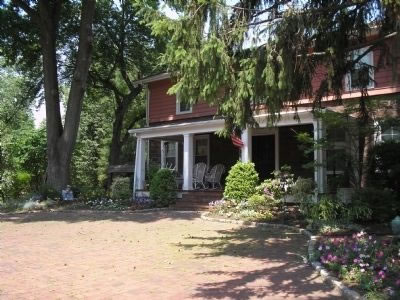
(Photo by
Bill Coughlin, courtesy of HMdb.org)
Built about 1795 by Henry S. Terhune in “Old Paramus” on
land owned by the Terhune family since 1707. the
two-hundred acre farm extended for over a mile between
the Saddle River and Sprout Brook. In 1853 the house was
inherited by Terhune’s grandson, John Zabriskie Van Dien,
and was owned by his family for three generations. Alterations
to the farmhouse have been made over the years.
Washington Spring
Van Saun County Park, Washington Gardens
Paramus, NJ 07652
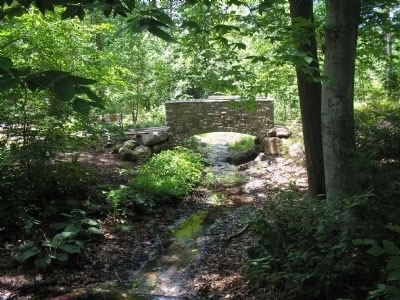
(Photo by
Bill Coughlin, courtesy of HMdb.org)
General George Washington is believed to have taken a
drink from this spring on September 13, 1780, after
reviewing his troops. With him were six local Indian chiefs
who attended the ceremony.
Ackerson Homestead
142 Pascack Road
Park Ridge, NJ 07656
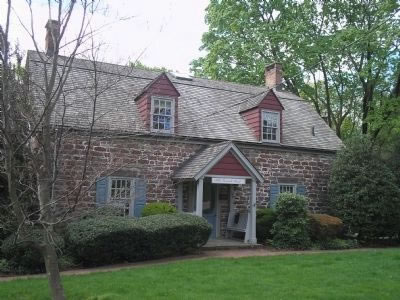
(Photo by
Bill Coughlin, courtesy of HMdb.org)
Built about 1800 by John Ackerson and son Garret, this stone
house stands on land purchased in 1759. The property was
developed during a century of family ownership. A general
store was built opposite the house site in 1777 and successive
generations built a distillery and a woolen mill beside the
Pascack Brook. In 1857 the homestead was sold to Levi
Gurnee who also operated the general store for forty years.
Pascack Historical Society Museum
19 Ridge Avenue
Park Ridge, NJ 07656
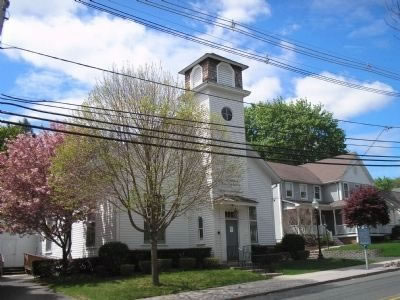
(Photo by
Bill Coughlin, courtesy of HMdb.org)
This building, dedicated December 8, 1873 by Rev. Henry
Ward Beecher, was built through the efforts of James Leach,
James Hall and Jacob, his son, for use as a Sunday school
and mission chapel. In 1875 it became a Congregational
Church. The first local library was founded here. The
building was acquired by the Pascack Historical Society
in 1852 for its headquarters and a museum founded by
John C. Storms.
Pascack Reformed Church
Pascack Road and Sulak Lane
Park Ridge, NJ 07656
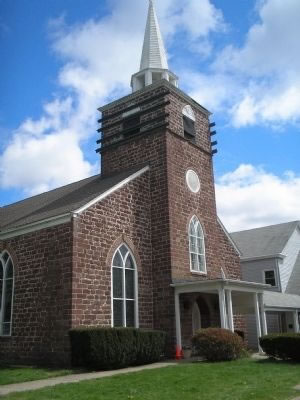
(Photo by
Bill Coughlin, courtesy of HMdb.org)
Erected in 1813 on farmland purchased from
the Campbell and Wortendyke families, the
church had thirty-six original members.
Dedicated in the Fall of that year by Dominie
Stephen Goetschius, the first pastor, who
called it a “beautiful and well-proportioned”
House of God. Built of local sandstone and
timber, the labor was performed by members
from Pascack and Saddle River, where a joint
pastorate existed until 1854.
Wortendyke Dutch Barn
Pascack Road
Park Ridge, NJ 07656
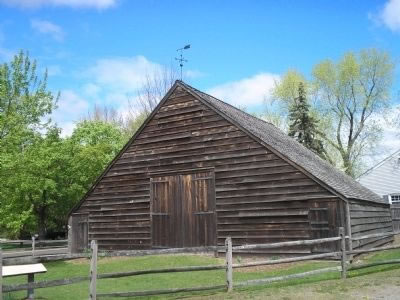
(Photo by
Bill Coughlin, courtesy of HMdb.org)
This pre-Revolutionary Dutch barn was built by the
Wortendyke family. Once common in the Hudson River
area, the barn is one of the few remaining in this country.
Broader than deep, the structure is entirely supported by
four H-frames tied with massive anchor beams. Front and
rear wagon doors permit through access to the threshing
floor, which is flanked by side aisles for animals.
Wortendyke Homestead
12 Pascack Road
Park Ridge, NJ 07656
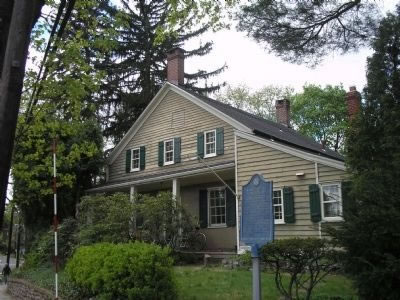
(Photo by
Bill Coughlin, courtesy of HMdb.org)
Frederick Wortendyke, Jr. built the original sandstone
section of this farmhouse in the 1750’s. Located at “Pascack”
on land purchased by his father in 1735, the tract included
nearly a third of present-day Park Ridge. The homestead
was enlarged before 1775 and was further expanded and
remodeled over the years. It remained in the Wortendyke
family until 1851.
David Van Gelder House
37 W. Crescent Avenue
Ramsey, NJ 07446
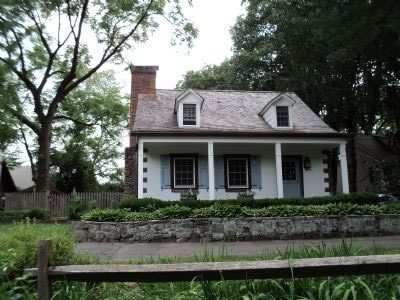
(Photo by
Bill Coughlin, courtesy of HMdb.org)
Built by David Van Gelder after his marriage in 1794.
Located in the area once called “Brabant”, the land was
purchased twice – c. 1737 and 1745 – by grandfather
Abraham to insure valid title from the proprietors of East
New Jersey. It included most of nearby Van Gelder’s Pond.
Inherited by David’s son Abraham B. in 1845, he willed it to
his sister Pernelphe, a farmer, in 1876. The house remained
in the Van Gelder family name until 1884.
English Neighborhood Reformed Church
1040 Edgewater Avenue
Ridgefield, NJ 07657
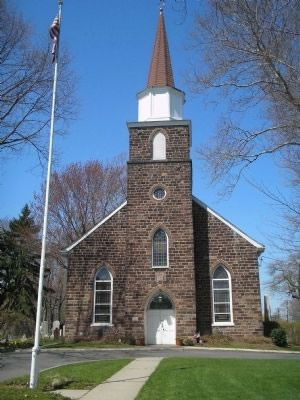
(Photo by
Bill Coughlin, courtesy of HMdb.org)
Organized in 1770 as a Dutch Reformed Church,
the first building, erected in 1768, was located
in Leonia. After the Revolution, it was decided
to “Erect a New One in A more Proper Place”.
In 1793 the present church was built on the
farm of Cornelius Vreelandt in the locality
once known as the “Point”. Stone from the
first building was used in construction of this
church which has survived without major
alteration.
Paulison-Christie House
8 Homestead Place
Ridgefield Park, NJ 07660
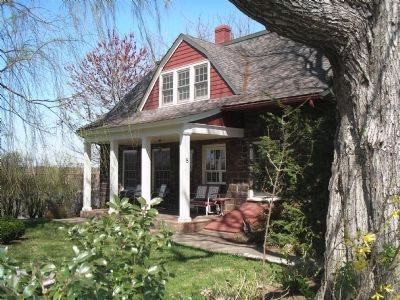
(Photo by
Bill Coughlin, courtesy of HMdb.org)
Built about 1775 by John Paulison who owned 150 acres in
what was then known as “Old Hackensack”. The farm was
raided by the British during the Revolutionary War. In 1826
the house was inherited by his son Paul Paulison.
Purchased in 1844 by David Christie for his son Albert
Brinkerhoff Christie. The farmhouse remained in the
Christie family for 140 years and has seen additions
and alterations over the years.
Joseph H Chapman Summer Residence
W. Ridgewood Avenue
Ridgewood, NJ 07450
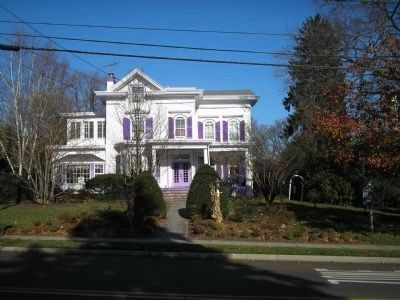
(Photo by
Bill Coughlin, courtesy of HMdb.org)
Built about 1869 in the late Italianate style of architecture,
it was the summer home of Joseph H. Chapman who was
a Wall St. insurance agent. In 1868 a group of investors
laid out streets and house lots and named the development
Ridgewood Park. As it was convenient to the Erie
R. R. station, the area attracted commuters who contributed
to the growth of Ridgewood. The house exterior has had
few changes over the years.
Old Paramus Reformed Church
E. Glen Avenue
Ridgewood, NJ 07450
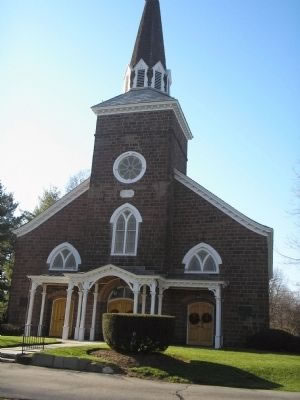
(Photo by
Bill Coughlin, courtesy of HMdb.org)
Organized in 1725 by pioneer Dutch settlers,
the congregation of this church has worshipped
here over 240 years. First church, built 1735
on this land given by Peter Fauconier, a French
Huguenot, was a headquarters of Gen. George
Washington in 1778 and 1780. During the
American Revolution it was used as a barracks,
hospital and prison. Present structure, a model
of Dutch Colonial architecture, was completed
in 1800 using stones from the original church.
Schoolhouse Museum
650 Glen Avenue
Ridgewood, NJ 07450
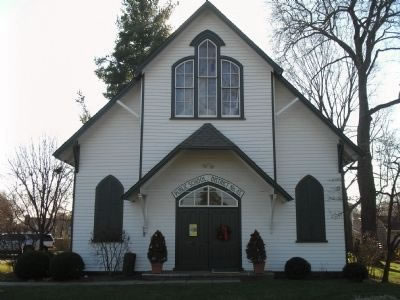
(Photo by
Bill Coughlin, courtesy of HMdb.org)
Built in 1872, this school is believed to be the fifth one
erected on Paramus Reformed Church ground. From 1730
to the 1870s, education was carried on by the church.
Rented to Ridgewood Township, it became District
School No. 45 from the 1870s to 1905. Since April 23, 1955
it has housed the museum of the Paramus Historical and
Preservation Society.
Van Dien House
629 Grove Street
Ridgewood, NJ 07450
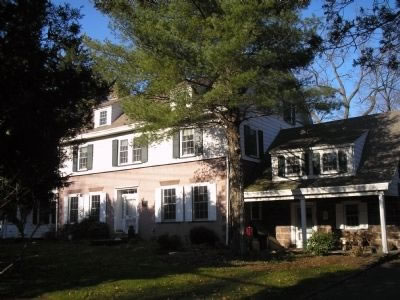
(Photo by
Bill Coughlin, courtesy of HMdb.org)
Located on property purchased by Garret Van Dien about
1713, this house was built by a descendant, and is a
combination of 18th and 19th century architecture. It has
been enlarged over the years and remained in the Van
Dien family until 1900.
Campbell-Christie House
Main Street
River Edge, NJ 07661
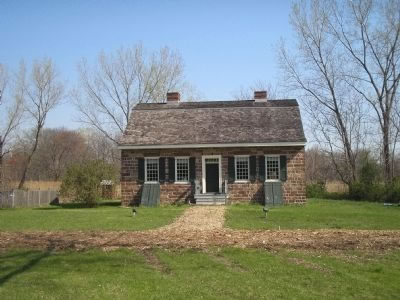
(Photo by
Bill Coughlin, courtesy of HMdb.org)
Willem Campbell built this house in April 1774 in New Milford.
He and his wife raised 9 children in the house, four of the
sons going on to serve in the Bergen Militia during the
Revolutionary War. The house was moved to this location
on September 27, 1977.
Baylor Massacre Burial Site & Park
River Vale Road & Red Oak Drive
River Vale, NJ
201-336-7267
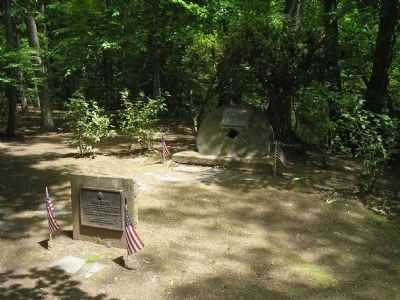
(Photo by
Bill Coughlin, courtesy of HMdb.org)
Burial site in memory of American soldiers killed during
the Revolutionary War in the "Baylor Massacre" on
September 28, 1778. Lt. Col. George Baylor's 3rd Regiment
of Continental Dragoons took quarters for the night on
several nearby farms. Tories betrayed their presence to a
British force, who surrounded the Dragoons during the night.
A number of Americans were killed or wounded after
they had surrendered.
Blauvelt-Seaman House
725 Rivervale Road
River Vale, NJ 07675
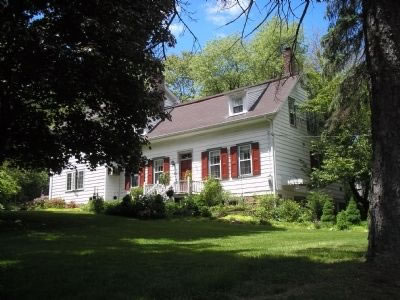
(Photo by
Bill Coughlin, courtesy of HMdb.org)
Built about 1828 by David C. Blauvelt on land he purchased
in 1801. The 37 acre farm was situated in the locality once
known as Overkill Neighborhood. David was a blacksmith
and after his death, son John D. Blauvelt bought the
homestead in 1842. He sold it in 1882 to Margaret Leah,
wife of George H. Seaman, and the house remained in
the family until 1918.
Abraham A. Haring House
9 Piermont Road
Northvale, NJ 07647
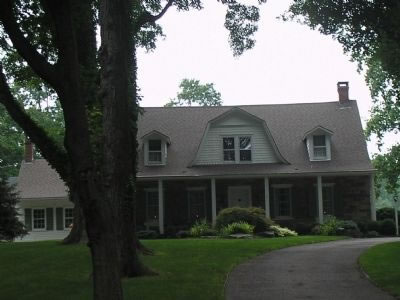
(Photo by
Bill Coughlin, courtesy of HMdb.org)
Erected on a 200 acre farm by Abraham A. Haring, a
captain in the Bergen County Militia. During the
Revolutionary War, Haring was captured by the British
and imprisoned in New York City where he died. In 1805
his grandson, Abraham D. Haring, sold the house to
Moses Taylor, Jr., who built the frame kitchen wing
about 1812. Taylor’s descendants owned the house
until 1902.
John A. Haring House
5 Piermont Road
Northvale, NJ 07647
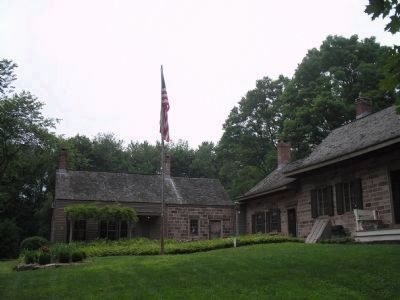
(Photo by
Bill Coughlin, courtesy of HMdb.org)
An early 19th century example of Dutch Colonial architecture
erected by John A. Haring. Small wing added c. 1808;
rear stone section built by a Haring about the time of the
Revolutionary War.
Joseph Dubois House
Rockleigh Road
Rockleigh, NJ 07647
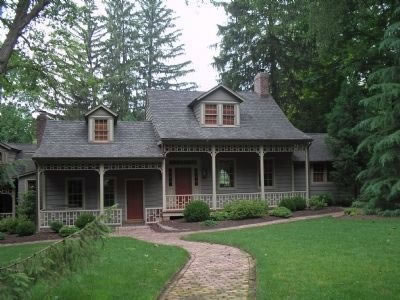
(Photo by
Bill Coughlin, courtesy of HMdb.org)
Erected by Joseph Dubois in the locality once known as
Rockland Neighborhood. South wing built in 1835, with
materials from 18th century house of John Gesner. Center
section built soon after with Victorian porch and north wing
added at a later date. Barn erected 1836. Dubois was a
Hudson River “boatman” and owner of a sloop operating
from nearby Snedens Landing.
Abraham P. Ackerman House
136 Chestnut Ridge Road
Saddle River, NJ 07458
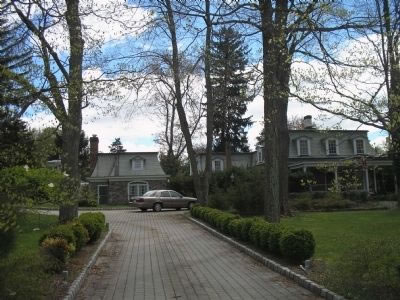
(Photo by
Bill Coughlin, courtesy of HMdb.org)
Built circa 1802 by Abraham P. Ackerman who added stone
kitchen wing soon after. Later, son William built frame unit.
His son Abraham W., owner in 1875, remodeled house and
added mansard roofs. The farmhouse remained in the
Ackerman family until 1880. Homestead property lines
became present roads – Woodcliff Lake Road in 1811 and
Chestnut Ridge Road in 1825.
Ackerman-Pell House
139 W. Saddle River Road
Saddle River, NJ 07458
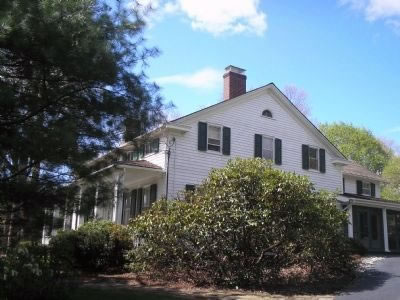
(Photo by
Bill Coughlin, courtesy of HMdb.org)
Built around 1835 in the Greek Revival style, it incorporates
parts of a late 18th c. home. John D. Ackerman was a miller
and his son, David I., was a blacksmith who built a trip hammer
forge on the Saddle River opposite the house. His grandson,
David Ackerman Pell, was sheriff and surrogate in the late
1800’s. David Ackerman Pell, 2nd, inherited the property
and was mayor of Saddle River for many years.
Brinkerhoff-Demarest House
493 Teaneck Road
Teaneck, NJ 07666
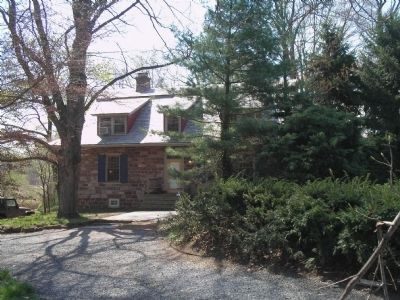
(Photo by
Bill Coughlin, courtesy of HMdb.org)
This old house was built around 1735 by Hendricks Brinkerhoff
on land owned by his grandfather since the 17th century.
An excellent example of early Dutch Architecture, it has been
in the possession of the Brinkerhoff and Demarest
descendants since it was built, and is one of the oldest
in Bergen County.
Everett-Dunn House
20 Forest Road
Tenafly, NJ 07670
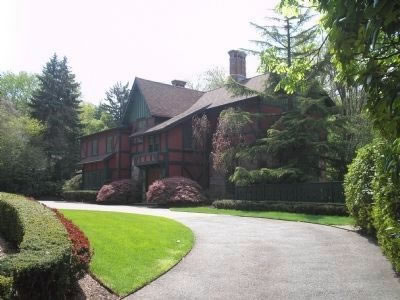
(Photo by
Bill Coughlin, courtesy of HMdb.org)
Built about 1867 for the Charles J. Everett family, this house
was designed by famous architect Richard Morris Hunt in the
Swiss Chalet style. Everett was noted as an inventor. In 1919
it became the home of Harvey Dunn, a prominent artist whose
studio was nearby. Both Everett and Dunn were active in
Tenafly civic affairs. The house has been enlarged and
remodeled over the years.
Roelof Westervelt House
256 Tenafly Road
Tenafly, NJ 07670
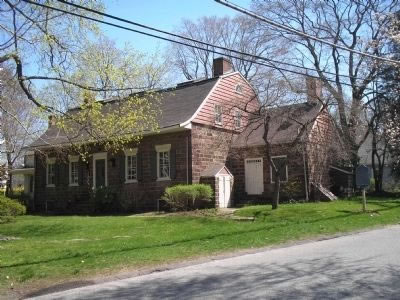
(Photo by
Bill Coughlin, courtesy of HMdb.org)
This house is a fine example of Dutch Colonial architecture.
The south wing of the house was built by Roelof Westervelt
in 1745. The land had been purchased by his grandfather,
in 1695, from the Lord Proprietores of East Jersey.
The central section of the house was completed around
1798, and the north wing was added in 1825. Ownership of
the house remained in the Westervelt family until 1923.
The Christie-Parcels House
Jefferson Avenue
Tenafly, NJ 07670
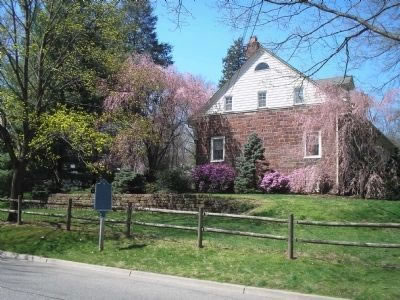
(Photo by
Bill Coughlin, courtesy of HMdb.org)
Stands on land purchased by William P. Christie for 500
pounds for 100 acres. In 1804 he built his home. Following
his sudden death, in order to be fair to the many heirs,
the house and the land were sold at auction to three buyers.
In 1836 Samuel Parsels erected the large wing east of the
Christie House. In 1860 he sold his property to Charles
Newcomb. This example of an early split-level house.
Tenafly Railroad Station
1 Piermont Drive
Tenafly, NJ 07670
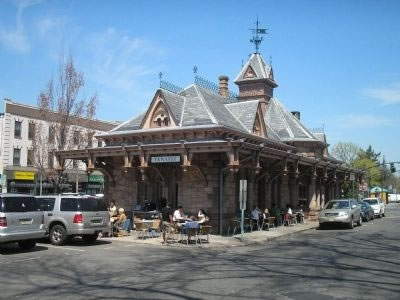
(Photo by
Bill Coughlin, courtesy of HMdb.org)
Built in 1872 when George Huyler donated the land and a
third of the cost. Residents and the Northern Railroad of
New Jersey shared equally in the balance. Designed in
High Victorian Gothic by Architect Daniel T. Atwood, the
station opened in 1874 serving rail and later trolley passengers.
Acquired in 1963 by the borough, restored with funds from
the New Jersey Historic Trust and Tenafly in 1994, the station
is once more a town focal point.
Teterboro Airport
Industrial Avenue
Teterboro, NJ 07608
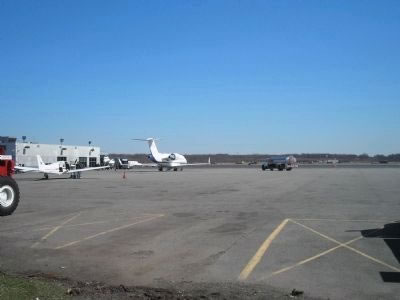
(Photo by
Bill Coughlin, courtesy of HMdb.org)
The home of Gates Flying Circus. Teterboro built Fokker
tri-motors flown by Richard E. Byrd over the North Pole (1926);
South Pole (1929); Atlantic (1927); and by Amelia Earhart
over Atlantic (1928). Clarence Chamberlin, Ruth Nichols,
Floyd Bennett, Charles A. Lindbergh, Bernt Balchen and
Bill Odom flew here. First airmail route flown to Boston (1926).
Teterboro is now (1972) a general aviation airport.
Hopper-Goetschius House
East Saddle River Road and Lake Street
Saddle River, NJ 07458
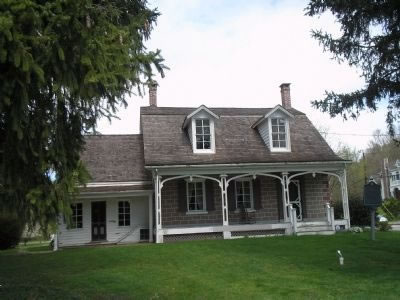
(Photo by
Bill Coughlin, courtesy of HMdb.org)
Abraham Hopper built a “new stone house” here (the west wing)
in 1739, according to surveyor Charles Clinton. The rest is
late 18th century. About 1813 it was bought by the
Rev. Stephen Goetschius (1752 – 1837), pastor of Old
Stone Church. Borough clerk Stephen J. Goetschius and
his wife Lizzie Carlough were the last residents. After over
170 years in the Goetschius family, the house was given to
the Borough by Clinton D. and Grace Carlough in 1985.
Saddle River Reformed Church & Cemetery
East Saddle River Road
Saddle River, NJ 07458
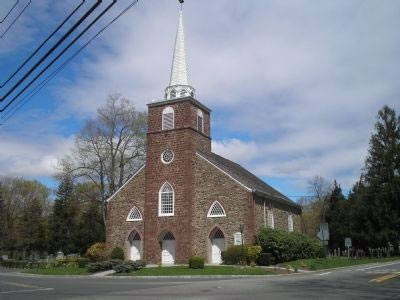
(Photo by
Bill Coughlin, courtesy of HMdb.org)
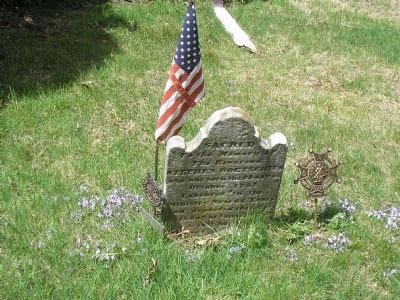
(Photo by
Bill Coughlin, courtesy of HMdb.org)
Known as, "The Old Stone Church",
it has been ministering
to
this area since 1784.
The present structure
of native stone
was completed in 1819.
Buried here are:
The Rev. Stephen
Goetschius
minister 1819-1835,
The Rev. Dr. Isaac Van
Kampen
minister 1893-1935, and many Revolutionary and
Civil war veterans.
Seven Chimneys House
25 Chimney Ridge Court
Washington Township, NJ 07676
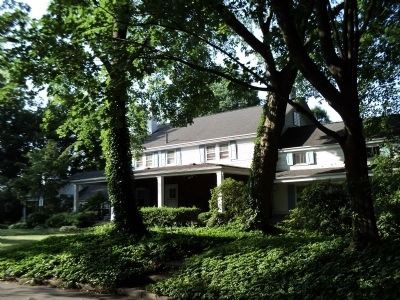
(Photo by
Bill Coughlin, courtesy of HMdb.org)
Oldest house in Washington Township, built by Nicholas
Zabriskie about 1750. Wings added after 1770 and second
story frame raised above original native sandstone in 1812.
Tradition says house was an Underground Railway depot for
escaping slaves before Civil War. Theodore Roosevelt is said
to have been a frequent visitor between 1915 and 1917.
Peter P. Post House
259 Pascack Road
Woodcliff Lake, NJ 07677
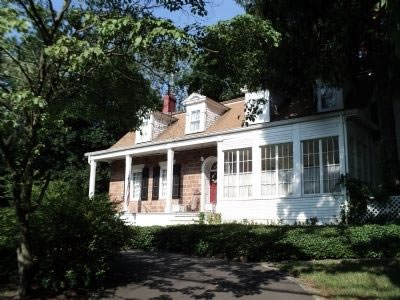
(Photo by
Bill Coughlin, courtesy of HMdb.org)
This sandstone and frame house was built about 1794 by
Peter P. Post, a third generation miller from Pompton,
who settled here in 1789 and operated a gristmill along
nearby Bear Brook. Later owners included the
Abraham J. Demarest family who were occupants for
fifty years. Combining country and Federal styles of architecture,
the house was enlarged and remodeled in the late 1800’s.
Brinkerhoff House
231 Hackensack Street
Wood Ridge, NJ 07075
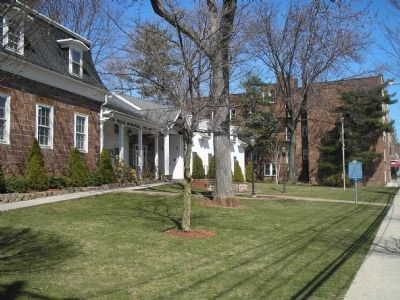
(Photo by
Bill Coughlin, courtesy of HMdb.org)
Located in old “Polifly”, George Brinkerhoff built this house
about 1792 on a 200 acre farm he purchased in 1784.
Owned in 1806 by son Henry G. and in 1849 by his son,
Enoch, a N.J. Assemblyman. In the 1870’s, great-grandson
Henry E. remodeled the house. He later became a founding
councilman of the Borough of Wood-Ridge. Purchased in
1905 by Leopold Brandenburg, Mayor in 1918-19.
The house was renovated as the town memorial library
in 1954.
Stagg Homestead
Sicomac Avenue
Wyckoff, NJ 07481
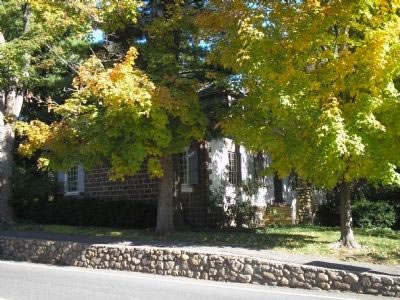
(Photo by
Bill Coughlin, courtesy of HMdb.org)
Erected about 1812 by John C. Stagg on site of earlier
building owned by his father, Cornelius Stagg, a veteran
of the Revolutionary War. The basement was operated as
a grocery store for many years by John C. Stagg. His son,
Albert, sold to Richard Terhune in 1846. Judge Nehemiah Millard,
one of the area’s first railroad commuters to New York City,
purchased house in 1868. It was later owned by the
MacDonald family.
Van Voorhees-Quackenbush-Zabriskie House
421 Franklin Avenue
Wykoff, NJ 07481
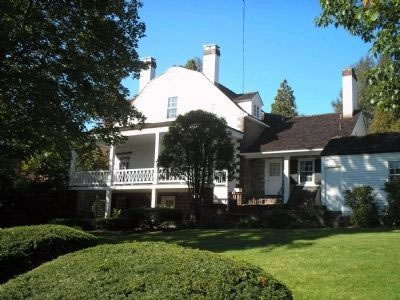
(Photo by
Bill Coughlin, courtesy of HMdb.org)
Built in 1824 by Albert Van Voorhees, this Federal home
replaced his earlier house. The land, owned by father
William since 1720, was called “Wikehoff”. Albert, a veteran
of the Revolution and a Justice, deeded the new home to
grandson Albert J. Van Voorheis. In 1867 it was purchased
by Uriah Quackenbush who willed it to his granddaughter,
Grace Quackenbush Zabriskie. She bequeathed the home
to the Town of Wyckoff in 1973.
Wyckoff Reformed Church
580 Wyckoff Avenue
Wyckoff, NJ 07481
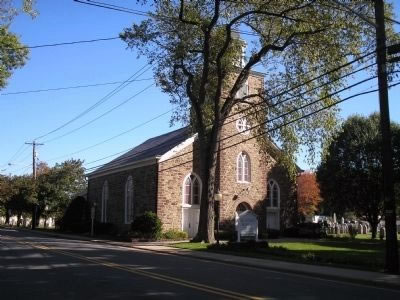
(Photo by
Bill Coughlin, courtesy of HMdb.org)
Once known as the Reformed Dutch Church of Wyckoff,
this was the first church to be erected in the Township.
It was established by members of Ponds Church at Oakland
who lived in this area. They constructed the building of local
stone and timber on one-half acre of land purchased in 1805.
Peter DeWitt was the first pastor. Early settlers are buried
in the churchyard.
Bank House
14 Washington Place
Hackensack, NJ 07601
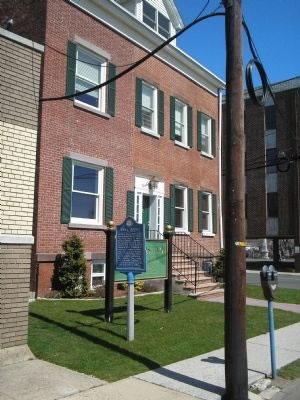
(Photo by
Bill Coughlin, courtesy of HMdb.org)
Erected about 1831 by the Washington Banking
Company. The first bank in present Bergen County,
it opened in the nearby Mansion House in 1825-26.
After the bank failed in 1833, it housed the offices
of prominent lawyers and judges. Later the home
of the “New Jersey Citizen”, a newspaper published
in the 1870’s. The original Federal style building
was enlarged by additions to the side and rear
in 1909.
Camp Merritt Memorial
Madison Avenue and Knickerbocker Road
Cresskill, NJ 07626
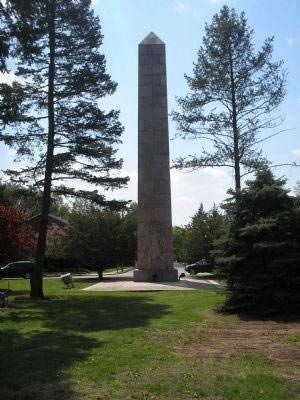
(Photo by
Bill Coughlin, courtesy of HMdb.org)
In memory of those soldiers who gave their
lives for their country while on duty in Camp Merritt.
This monument marks the center of the camp
and faces the highway over which more than a
million American soldiers passed on their way
to and from the World War 1917-1919.
Erected by the State of New Jersey,
the County of Bergen, The Bergen County
Historical Society, Officers and men of Camp
Merritt. Many patriotic citizens and the
Camp Merritt Memorial Association.
Aviation Hall of Fame
400 Fred Wehran Drive
Teterboro, NJ 07608
201-288-6344
Founded in 1972, the Aviation Hall of Fame & Museum of New Jersey is dedicated to the preservation of the Garden State's distinguished, two-century aviation and space heritage.
Bergen Museum of Art & Science
Paramus, NJ
845-918-4577
Bergen Performing Arts Center
30 North Van Brundt Street
Englewood, NJ 07631
201-816-3160
Hiram Blauvelt Art Museum
705 Kindermack Road
Oradell, NJ 07649
201-261-0012
New Jersey Children's Museum
599 Valley Health Plaza
Paramus, NJ 07652
201-262-5151
The Art School at Old Church
561 Piermont Road
Demarest, NJ 07627
The Art School at Old Church is an art school and fine art gallery offering art classes, craft classes, workshops, children's classes, art exhibits & more.
The Ridgewood Art Institute
12 East Glen Avenue
Ridgewood, NJ 07450
201-652-9615
Non-profit organization made up of professional and amateur artists who represent and perpetuate America's heritage of traditional realism in painting and drawing.
Attention NJ shoppers!
Get njtgo.com's VIP savings card and get discounts at participating vendors all over the New Jersey.
